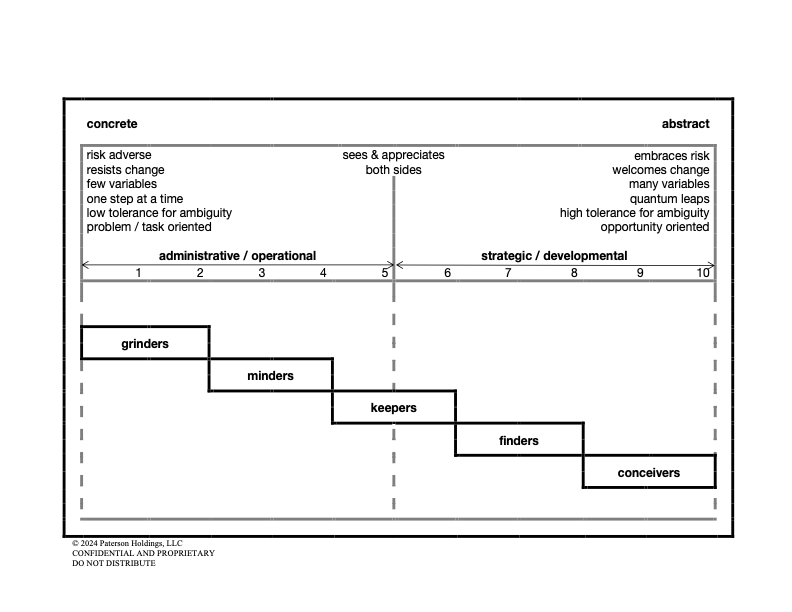WHAT’S YOUR WAVELENGTH?
GRINDERS get the work done. They are detail-doers. Grinders document things, are risk-adverse, like few variables, take things one step at a time, have a low tolerance for ambiguity, understand tasks and the need to solve problems, handle administrative details well, and deliver working drawings. They do the same thing over and over again, year after year - and love it. If you change the way they do things, you will hear from them. The world cannot operate without grinders. By the way, real grinders are not offended by this term. They proudly grind it out, day after day.
MINDERS can manage a unit team, having both the people skills and the organizational abilities to do so. They can supervise the performance of work. They function best as frontline supervisors, have the ability to diagnose problems, “mind the store,” and put out “brush fires.” They can run a department, ministry or program and manage people in their area of expertise. They are usually supervisors, teachers, chief engineers, section leaders, ministry program leaders and foremen. They can be counted on to keep the processes and teams functioning and running well.
KEEPERS are capable of managing the whole store, possessing an appreciation for the administrative and the strategic. They have both concrete and abstract thinking skills, but will be biased to the administrative/operational work. They make great mediators in conflicts, good personnel managers, directors of departments or ministry programs, plant managers, and executive assistants. They handle details and see the broader vision. They handle many variables, are organized, and good with people.
FINDERS are often entrepreneurs, in some form. They are abstract thinkers, so they oftentimes don’t complete the paperwork that concrete thinkers require. They may appear to be loose cannons in a group structure. They are innovators and creators. Follow-through is not always their strength. They need grinders, minders, and keepers to follow in their wake of creativity. They sense and seize opportunities, spot voids and fill them, are bored by a steady state, are good site locators, love a new challenge, must be thrown “raw meat” regularly. They are usually the chief executive officer, chief visionary, lead pastor, leader of a major ministry, product or market manager, joint venture leader, and advanced development engineer. Unlike conceivers, finders want to ensure that their ideas work in the first-generation prototype. But once they are assured that it does, they must hand it off to a keeper to build upon and find something else to find.
CONCEIVERS are usually bright, articulate and persuasive, but they don’t bring things to closure. They work best in universities, seminaries, and pure research laboratories. They don’t belong in business. They cannot manage others well, and their ideas rarely become commercialized or brought to the masses. They are oftentimes criticized for “all talk and no follow through.” They embrace risks, draw little sketches, can make quantum leaps, welcome change, are strategic, produce seminal concepts, enjoy manay variables, are opportunity oriented, have a high tolerance for ambiguity, postulate the new (but don’t execute), and love the forty-thousand-foot-macro-view. Conceivers are theorists typically employed as researchers, philosophy professors, theologians, and innovators.
Reflection Question:
If you had to choose one spot on a scale from 1 to 10—and live there for the rest of your life—where would you be the happiest and contribute the most?
Your number: _______________
Most likely, the number you picked is within 1.0 of the number you calculated when you added up the six numbers and divided by six earlier. Take these two numbers and split the difference (e.g., if you had a “6.5” on the first score and picked a “7.5”, then call it a 7.0). This is your high-contribution zone.
Now chart where you spend 80% of your time in your current role.
How close is it to your thinking wavelength high-contribution zone? If it’s within 1.0, it’s a good match. If it’s more than 2.0, it’s problematic. Those who have more than a 2.0 gap oftentimes quit, are fired or move on in some way within 18 months unless this gap is narrowed. If they don’t narrow the gap, depression, frustration, burnout and illness from the stress of living too far away from their high-contribution zone set in.
© Copyright 2024 Paterson Holdings, LLC. Confidential and proprietary. Do Not Distribute. All Rights Reserved

